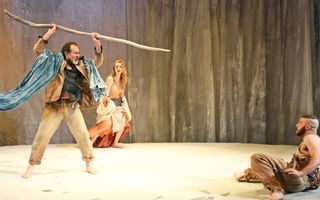 Watch
Watch
- The Tempest is generally believed to be the final play Shakespeare wrote as sole playwright. Many have connected Prospero’s relinquishing of his magic to Shakespeare giving up his own ‘art’, though there is no proof of this.
- The Tempest is the third shortest play in the canon, after The Comedy of Errors and A Midsummer Night’s Dream
- The play has the longest and most elaborate stage directions of all of Shakespeare’s works.
- Prospero speaks about 30% of the lines in the play.
- The Tempest has more music in it than any other Shakespeare play.
- Several common phrases originated from this play, such as “in a pickle” (Act 5, Scene 1), “brave new world” (Act 5, scene 1), “sea change” (Act 1, Scene 2), and “into thin air” (Act 4, Scene 1).
- The Tempest is one of two plays of Shakespeare’s that observes Aristotle's Unities of Time, Place and Action – meaning the story takes place within one day, in one location, and every incident in the play contributes to the main plot. (The other play is The Comedy of Errors).
- Nine of the moons belonging to the planet Uranus are named after characters from The Tempest: Ariel, Miranda, Caliban, Sycorax, Prospero, Stephano, Trinculo, Francisco, Ferdinand, and the god Setebos.
- The Tempest has the lowest number of human female characters out of all of his plays, with Miranda being the sole one. Not counting the spirit deities, Iris Juno and Ceres, of course.
- The play inspired the 1948 American Western Yellow Sky, starring Gregory Peck, and the 1956 science-fiction classic Forbidden Planet.
- Ron Daniels directed a production of this play for the Royal Shakespeare Company in 1982 in which Ariel and Caliban were only aspects of Prospero’s psyche.
- The first Australian performance of The Tempest was in 1838 in Hobart at the Theatre Royal. They used John Dryden’s and Sir William Davenant’s 1667 adaptation, which was called The Enchanted Island.






